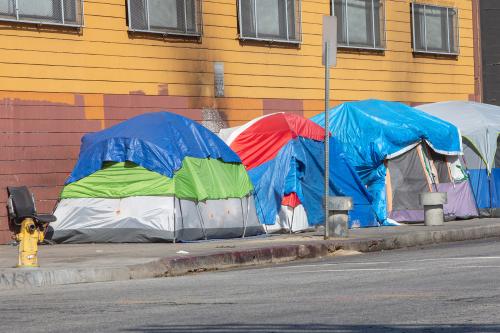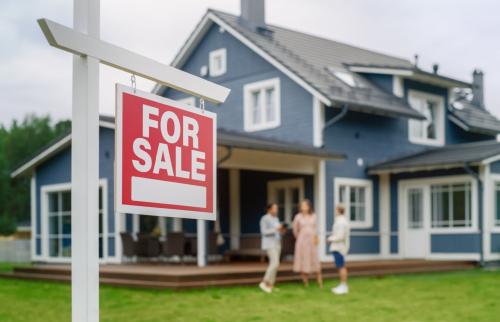Last fall, the California legislature made headlines by passing Senate Bill 9, which legalized duplexes in single-family neighborhoods throughout the state. The bill is the most recent legislative effort aimed at alleviating the state’s chronic housing shortage through adding “gentle density,” and its passage represents a significant political victory for state and local pro-housing advocacy groups, spearheaded by California YIMBY (short for “Yes In My Backyard”).
The emergence of such visible and vocal pro-housing groups has become a defining feature in land use debates over the past several years—a counterbalance to long-standing homeowners who oppose new housing, often referred to as NIMBYs, for “Not In My Backyard.” Since the Great Recession, housing supply has failed to keep up with demand, leading to rapidly rising housing costs and sparking ever more heated political arguments, from California to Minneapolis, Massachusetts, and Utah. While media reports offer snapshots of where and how pro-housing groups operate, systematic data collection and academic research about them are still thin.
In this brief, we analyze newly collected data (see Appendix A) to provide an overview of the emerging pro-housing movement. More than 140 of these groups existed as of January 2022, although their size and activity level vary. Nearly 60% of states (29) have at least one active group, with the highest concentrations in California, Massachusetts, Texas, and Washington. Understanding where, how, and why pro-housing groups emerge—and how they impact housing policies and markets—are important areas for further research.
Pro-housing groups are growing rapidly, and are mostly oriented toward local politics
Housing affordability has gained noticeably more political attention at the national level within the past five years, with both Democratic and Republican elected officials calling out the need for zoning reforms to increase housing supply. The number of pro-housing groups has expanded rapidly over this time; nearly half of the groups in our dataset were formed within the last two years alone.
 Our analysis found that two-thirds of pro-housing groups focus on a single city or county. This makes sense, because local governments are primarily responsible for adopting land use regulations (such as apartment bans and large minimum lot sizes) and overseeing housing production. Some cities, such as San Francisco and Boston, have neighborhood-level groups organizing within cities (Grow the Richmond, Dorchester Growing Together). Groups that aim for policy change at the state level (Texans for Housing, YIMBY Utah, YIMBY Maryland) account for only 8% of pro-housing groups. And only 4% of pro-housing groups have a national focus; several of these (YIMBY Action, Up for Growth) also advocate for local housing needs nationwide.
Our analysis found that two-thirds of pro-housing groups focus on a single city or county. This makes sense, because local governments are primarily responsible for adopting land use regulations (such as apartment bans and large minimum lot sizes) and overseeing housing production. Some cities, such as San Francisco and Boston, have neighborhood-level groups organizing within cities (Grow the Richmond, Dorchester Growing Together). Groups that aim for policy change at the state level (Texans for Housing, YIMBY Utah, YIMBY Maryland) account for only 8% of pro-housing groups. And only 4% of pro-housing groups have a national focus; several of these (YIMBY Action, Up for Growth) also advocate for local housing needs nationwide.
 Note: Groups are assigned to geographic categories by name. “Local” indicates groups focus on specific cities or counties. “Neighborhood” indicates a within-city focus. “Metropolitan” includes more than one jurisdiction within a metro area. “State” includes statewide organizations. “National” includes multistate organizations.
Note: Groups are assigned to geographic categories by name. “Local” indicates groups focus on specific cities or counties. “Neighborhood” indicates a within-city focus. “Metropolitan” includes more than one jurisdiction within a metro area. “State” includes statewide organizations. “National” includes multistate organizations.
We intentionally applied broad criteria in identifying pro-housing groups, and were not able to gather detailed information about group characteristics, such as budget or number of participating members. But secondary research indicates that pro-housing groups vary widely on two dimensions that likely impact their work: size and organizational ties. Groups in our inventory run the gamut from one person with a Twitter account to legally incorporated entities with both full-time paid staff and volunteers. Some groups operate as educational or charitable nonprofits, while others are classified as lobbying or political advocacy groups.
Many of these groups operate under an umbrella structure of affiliates, conceptually similar to parent company and franchise arrangements among for-profit firms. The largest of these is YIMBY Action, headquartered in San Francisco, which provides funding, training, and coordination for dozens of local chapters across the country. The other nationally focused group, Washington, D.C.-based Up for Growth, operates a research and policy-focused nonprofit as well as an affiliated lobbying group (Up for Growth Action) that advocates for pro-housing federal legislation.
Pro-housing organizations are most concentrated on the West Coast
Forty-five of the 100 largest U.S. metro areas have at least one pro-housing group. Metro areas along the West Coast have the highest concentration of pro-housing groups, while Greater Boston has the highest number of groups among East Coast metro areas.
 Pro-housing groups are especially prevalent in high-cost metro areas, but there isn’t a perfect correlation between these two factors (Figure 4). The San Francisco metro area has more than twice as many groups as Los Angeles, although the latter is much larger and has similar affordability (housing values relative to income). Similarly, many more groups are active in Greater Boston and Washington, D.C. than New York, which has twice as many people as the other two metro areas combined, as well as famously high housing costs. Understanding what economic, political, and institutional factors lead to pro-housing advocacy is a promising area for future research.
Pro-housing groups are especially prevalent in high-cost metro areas, but there isn’t a perfect correlation between these two factors (Figure 4). The San Francisco metro area has more than twice as many groups as Los Angeles, although the latter is much larger and has similar affordability (housing values relative to income). Similarly, many more groups are active in Greater Boston and Washington, D.C. than New York, which has twice as many people as the other two metro areas combined, as well as famously high housing costs. Understanding what economic, political, and institutional factors lead to pro-housing advocacy is a promising area for future research.

Not all pro-housing organizations embrace the term ‘YIMBY’
The pro-housing movement emerged in direct response to NIMBYism, and nearly half the groups in our dataset use the term YIMBY—”Yes In My Backyard”—to describe themselves. But the term YIMBY has acquired some political baggage, both over differences in policy priorities with traditional affordable housing advocates and choice of tactics. Some pro-housing groups have strategically chosen to avoid the YIMBY-NIMBY framing altogether, selecting names like Minneapolis’ Neighbors for More Neighbors or Abundant Housing Massachusetts.
Still, YIMBY is the most commonly used term in pro-housing group names (Figure 5), with another 7% of groups choosing names that include either “neighbors” or some formulation of “house” or “housing.” Many groups also have distinctly local names, such as A Better Cambridge and Greater Greater Washington.
 Naming conventions vary somewhat across regions of the country. Three-fifths of pro-housing groups in the South use the term “YIMBY” in their name, compared with two-fifths of groups in the West, Northeast, and Midwest.
Naming conventions vary somewhat across regions of the country. Three-fifths of pro-housing groups in the South use the term “YIMBY” in their name, compared with two-fifths of groups in the West, Northeast, and Midwest.
What should be on the local housing politics research agenda?
The rapidly growing, decentralized pro-housing movement has emerged in response to a tangible economic problem: Housing costs are rising faster than incomes, creating financial stress for more households. Political engagement around this issue has mobilized social media to raise awareness, which has drawn the attention of elected officials. Notably, the pro-housing movement is not exclusively aligned with either major political party; politicians in both parties, from Sen. Amy Klobuchar (D-Minn.) and Rep. Alexandria Ocasio-Cortez (D-N.Y.) to Governor Charlie Baker (R-Mass.) and Sen. Todd Young (R-Ind.), have supported pro-housing legislation. At the state and local level, pro-housing groups have brought about small but tangible legislative victories, while just beginning to gain traction in other places.
As the pro-housing movement continues to grow and mature in political circles, it offers fruitful research questions relevant to economics, political science, sociology, and urban planning, among other disciplines. Some initial questions of interest include:
- How and why do local pro-housing groups form, grow, or decline? Do they build around specific policy proposals or “trigger events”? What strategies or actions build membership and/or visibility?
- Will the movement continue as loosely connected local and state organizations, or coalesce into more formal relationships?
- How do pro-housing groups fit into broader political movements? What relationships will form with political parties, traditional affordable housing advocacy groups, and the real estate industry?
- How successful are pro-housing groups at achieving policy change? What factors influence the likelihood of campaigns for zoning reforms and other policy changes?
Absent major policy changes, the economic fundamentals behind worsening housing affordability appear unlikely to change soon. As long as rents rise faster than incomes, the pro-housing movement is likely to engage new recruits.
Methodology note
Data was collected in January 2022 by looking at social media networks and cross-referenced with a thorough literature review of publications and news outlets. Data was included for pro-housing organizations doing advocacy or organizing work in the United States. Groups that had been inactive since 2020 were excluded. Organizations adjacent to the YIMBY movement, such as accessory development unit developers, but not directly involved in policy and advocacy were excluded. For our analysis, YIMBY Action “chapters” were counted as distinct organizations, however they operate under the management of YIMBY Action. This inventory likely didn’t capture every pro-housing group, especially if the group was not active on social media.
-
Acknowledgements and disclosures
Thanks to Laura Foote and Mike Kingsella for their helpful insights and comments.




Commentary
Where pro-housing groups are emerging
March 31, 2022